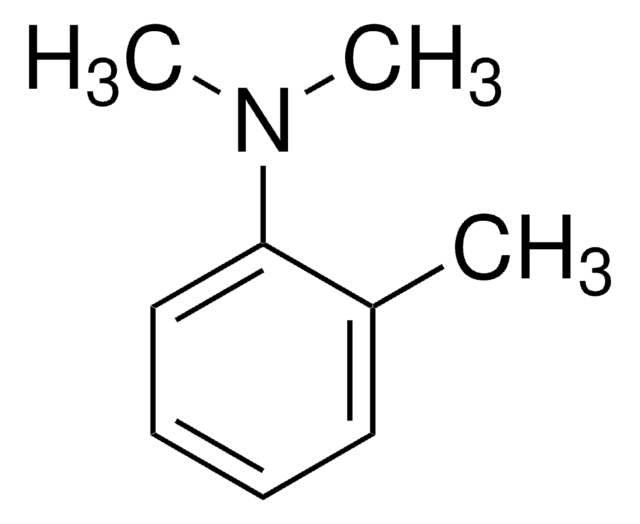41690
4,N,N-Trimethylaniline
catalyst grade (for peroxide polymerization), ≥98.5% (GC)
Sinônimo(s):
4-Dimethylaminotoluene, N,N-Dimethyl-p-toluidine
About This Item
Produtos recomendados
grau
catalyst grade (for peroxide polymerization)
densidade de vapor
>1 (vs air)
Ensaio
≥98.5% (GC)
forma
liquid
Lim. expl.
7 %
índice de refração
n20/D 1.546 (lit.)
n20/D 1.547
pb
211 °C (lit.)
90-92 °C/10 mmHg (lit.)
densidade
0.936 g/mL at 20 °C
0.937 g/mL at 25 °C (lit.)
cadeia de caracteres SMILES
CN(C)c1ccc(C)cc1
InChI
1S/C9H13N/c1-8-4-6-9(7-5-8)10(2)3/h4-7H,1-3H3
chave InChI
GYVGXEWAOAAJEU-UHFFFAOYSA-N
Procurando produtos similares? Visita Guia de comparação de produtos
Categorias relacionadas
Descrição geral
Aplicação
- Charge-transfer complexes for redox polymerization: 4,N,N-Trimethylaniline used for on-demand amine/peroxide redox polymerization. This research offers a new perspective on the use of 4,N,N-Trimethylaniline in creating controlled polymer structures, which is crucial for various industrial and pharmaceutical applications (Garra et al., 2018).
Atenção
Palavra indicadora
Danger
Frases de perigo
Declarações de precaução
Classificações de perigo
Acute Tox. 2 Inhalation - Acute Tox. 3 Dermal - Acute Tox. 3 Oral - Aquatic Chronic 3 - Carc. 1B - Repr. 2 - Skin Sens. 1 - STOT RE 2 Oral
Órgãos-alvo
Reproductive organs
Código de classe de armazenamento
6.1A - Combustible acute toxic Cat. 1 and 2 / very toxic hazardous materials
Classe de risco de água (WGK)
WGK 3
Ponto de fulgor (°F)
168.8 °F - closed cup
Ponto de fulgor (°C)
76 °C - closed cup
Equipamento de proteção individual
Eyeshields, Faceshields, Gloves, type ABEK (EN14387) respirator filter
Certificados de análise (COA)
Busque Certificados de análise (COA) digitando o Número do Lote do produto. Os números de lote e remessa podem ser encontrados no rótulo de um produto após a palavra “Lot” ou “Batch”.
Já possui este produto?
Encontre a documentação dos produtos que você adquiriu recentemente na biblioteca de documentos.
Nossa equipe de cientistas tem experiência em todas as áreas de pesquisa, incluindo Life Sciences, ciência de materiais, síntese química, cromatografia, química analítica e muitas outras.
Entre em contato com a assistência técnica









